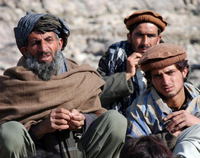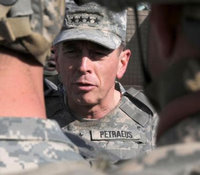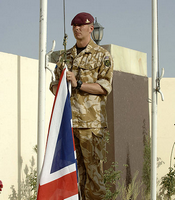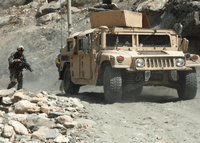To get an idea of how well President Barack Obama’s strategy for Pakistan-Afghanistan hit a political sweet spot, consider that people with as divergent an agenda as myself and Max Boot are both satisfied with it. What’s more, I’ve read and heard that after initial fears about the Biden-supported counterterrorism component winning out, the COIN crowd is pretty happy about the plan. But that was in the same day I read that the Obama strategy was simply a stepped-up COIN approach to a walked-back counterrorist objective. I think the reason everyone is breathing easier now is that first of all, […]
Afghanistan Archive
Free Newsletter
I’d like to call your attention to WPR’s latest feature issue, The Age of Counterinsurgency, which just went live today. Regular readers of the blog know that I’ve got a particular interest in this subject. I think today’s feature issue should give you an idea why. Counterinsurgency doctrine, or COIN, represents the first rough draft of the dominant strategic vision that has emerged from the post-9/11 era: that failed and failing states represent the principal national security threat to the U.S. because of the safe haven they might provide to transnational terrorist networks, and that only a full-spectrum, whole-of-government approach […]

KAPISA PROVINCE, Afghanistan — Standing on the HESCO barriers that ring Forward Operating Base Morales-Frazier in Kapisa Province, just north of Kabul, one can see three enormous, beautiful valleys. To the north lies the Nijrab, whose “fingers” are home to a mainly Tajik population, with some Pashtun areas. To the east sits Afghanya Valley, which hosts Pashtuns in its lower half and Pashai in its upper half. And to the south is Tagab Valley, an almost entirely Pashtun area that has become famous for its entrenched insurgency. FOB Morales-Frazier, the soldiers it hosts, and the area it stands watch over […]

Internecine ideological battles have bedeviled the foreign policy of every U.S. administration in recent memory. Human rights liberals fought unsuccessfully with Cold Warriors for control of the Carter administration. New-right hardliners initially won the war for Ronald Reagan’s foreign policy soul but then lost it to George Schultz’s old-guard Republican realists. The Clinton administration became an altar on which liberal interventionists exorcised the Democratic Party’s Vietnam Syndrome demons. Most bitterly and most tragically, the first term of George W. Bush’s presidency demonstrated what happens when neoconservatives and their allies win more ideological contests than they lose. Barack Obama’s young presidency […]
After seven years in Afghanistan, it’s back to basics. On Friday, President Barack Obama unveiled the results of his comprehensive and long-awaited policy review of the U.S. war strategy in South and Central Asia. Reining in what has become a discombobulated mission, he asked outright, “What is our purpose in Afghanistan?” He then went on to answer his own question: Our purpose is the pursuit of al-Qaida and its leadership, Osama bin Laden and Ayman al-Zawahiri. There is little surprise in that decision. Likewise, the new way forward offered few unexpected headlines. The strategy will focus on an approach to […]
Two more COIN-as-domestic-policing stories of note: The Naval Postgraduate School will be advising Salinas in that city’s anti-gang campaign (via Andrew Exum); and thanks to a combination of tough policing and community organizing, Compton is no longer the Capital CPT (via Matthew Yglesias). The former reinforces my suspicions that the military approach to counterinsurgency will find a sympathetic domestic law enforcement audience. The latter tempers the perceived threat by illustrating the ways in which the “smart power” approach to gangs and organized crime had already been formulated and applied before our current wars of counterinsurgency. In fact, back in 1997, […]
With regards to whether the expanded target list in Pakistan is authorized by the AUMF, a correspondent pointed out by e-mail that the AUMF has already been stretched pretty far and wide in geographic terms, and that finding a link between the folks we’d like to target and the folks we’re allowed to target — which is all we need to induct the former into the latter category — isn’t terribly difficult. A meeting over tea in the ole Waziristan compound, for instance, or a shout out on Radio Swat, would probably do the trick. Meanwhile, in answer to the […]
Noah Shachtman wants to know if we’re at war in Pakistan (as opposed to with Pakistan). He lays out the case here and here, with particular emphasis on the expanded target list in the Pakistani FATA, which amounts to U.S.assistance in a domestic Pakistani counterinsurgency campaign. Now, I’m not sure if what we’re doing is war, but I’m pretty sure it isn’t covered by the Congressional authorization for the Afghanistan War: . . . [T]he President is authorized to use all necessary and appropriateforce against those nations, organizations, or persons he determinesplanned, authorized, committed, or aided the terroristattacks that occurred […]

WASHINGTON — The new strategy for Afghanistan and Pakistan that the Obama administration unveiled today reflects a policy consensus that has been more than a year in the making. It is only recently, however, that the U.S. government has begun to take the lead in developing and implementing this new strategy. In the waning days of the Bush administration, U.S. allies — most notably the British government — as well as foreign policy wonks at think tanks in Washington and elsewhere began formulating an alternative policy for an Afghanistan war effort that had begun going downhill in the latter half […]
The Obama administration’s strategic review of the Afghanistan War is reportedly ready for roll out this afternoon. The NY Times has an advanced look, as does Marc Ambinder at the Atlantic. The plan, like all strategic reviews, seeks to first and foremost strike a balance between military necessities and political realities. As such, it threads the needle between two internal administration constituencies, and four external audiences. Within the administration, it incorporates the diplomatic full-court press of the “good governance is the key to hearts and minds” counterinsurgency advocates (see Seth Rosen’s WPR Briefing) with the more modest security objectives of […]

In his seminal essay the “Twenty-Seven Articles,” T.E. Lawrence wrote that “a bad start is difficult to atone for” in an insurgency or counterinsurgency effort. As the Obama administration prepares a new strategy for the war in Afghanistan, it is learning that lesson all too well. For more than seven years, Afghanistan has been the neglected war, impaired by insufficient resources, troops, planning and oversight. Facing a resurgent Taliban, the administration now has no choice but to chart a new path. Some of the president’s strongest supporters are urging him to scale down U.S. ambitions in the country. They contend […]
Jason Sigger passes along a very timely post from Sven Ortmann questioning the emerging “hybrid warfare” groupthink meme. Ortmann provides historical examples that illustrate how warfare has always involved both regular and irregular aspects. I’d add that victory is always asymmetric, since it involves bypassing the strength of the enemy, and that military innovation has always been the result of finding responses to superior capacities or resources. Cavalry was initially an asymmetric response to the superiority of massed infantry; artillery evolved out of the need to reduce the advantage inherent to defending fortresses. If there’s a difference, it’s that today’s […]
A few weeks back, I argued that the U.S. military’s emphasis on stability operations might not lead to increased counterinsurgency wars of choice, but speculated about ways in which it would almost certainly impact policymakers’ strategic vision. Here is the first item on that list: 1) An emphasis onstability as the strategic objective of American foreign policy. Thisis largely consistent with America’s historical emphasis, primarily dueto the benefits of stability to trade and commerce. But with failedstates now being perceived as a national security threat vector, thatwill probably increase. The downside is that promoting stability, ifpushed to an extreme, can […]
A smart, sensible essay from Ilan Goldenberg at Democracy Arsenal arguing for a Middle Path in Afghanistan, well worth a read. I think my biggest objection is that he’s proposing a Buddhist solution for an Islamic country. Other than that, it’s hard to argue with it. There are really no attractive options in Afghanistan. The maximalist approach assumes unlimited resources and political will, and the minimalist approach probably underestimates what a determined America can accomplish. As Goldenberg points out, the risk of a middle path is that it will be just enough to accomplish nothing. But it also might give […]
In many ways, Stephen Metz’s recent Small Wars Journal post is an echo of the ongoing debate over whether the ascendancy of counterinsurgency doctrine in the U.S. military will lead to a strategic shift towards more counterinsurgency wars of choice. COIN practitioners have argued that the enormous costs and complexities of counterinsurgency combined with the limited chances of success argue against widespread use. Their mantra is, Don’t confuse tactics with strategy. Metz, though, gives anecdotal evidence to the effect that the COIN focus on stabilizing states has already crept into the strategic assumptions of military futurists. He questions counterinsurgency not […]

KHOST PROVINCE, Afghanistan — The Army contractor reached into a green lacquered box and pulled out a clump of wires. He was holding part of the IED that had disabled his Mine Resistant Ambush Protection vehicle, or MRAP, just a few months before. “Here’s the thing I don’t get,” he said. “These guys use really nice German wires, but then they plug them into crappy, old, rundown Chinese batteries.” The explosion hadn’t done much, apart from frightening everyone inside. All it had left behind was a big hole in the dirt and a flat tire on the MRAP. But it […]
